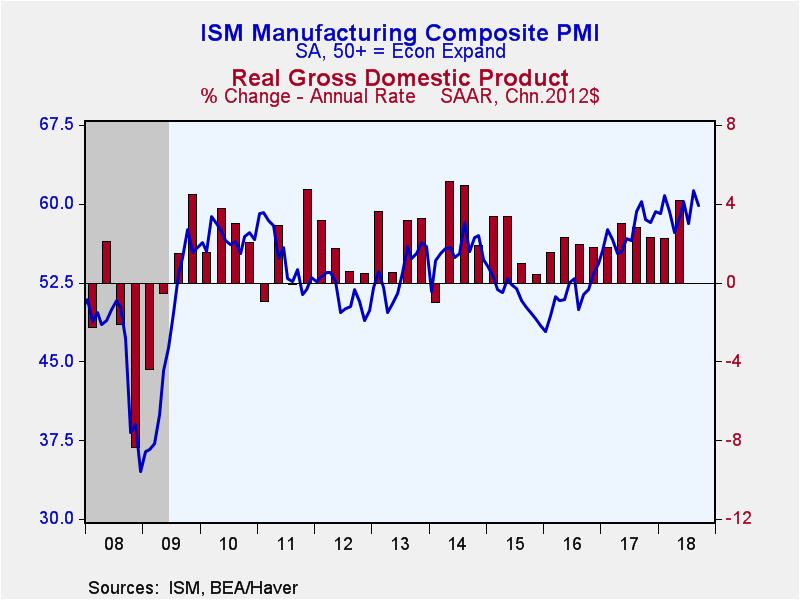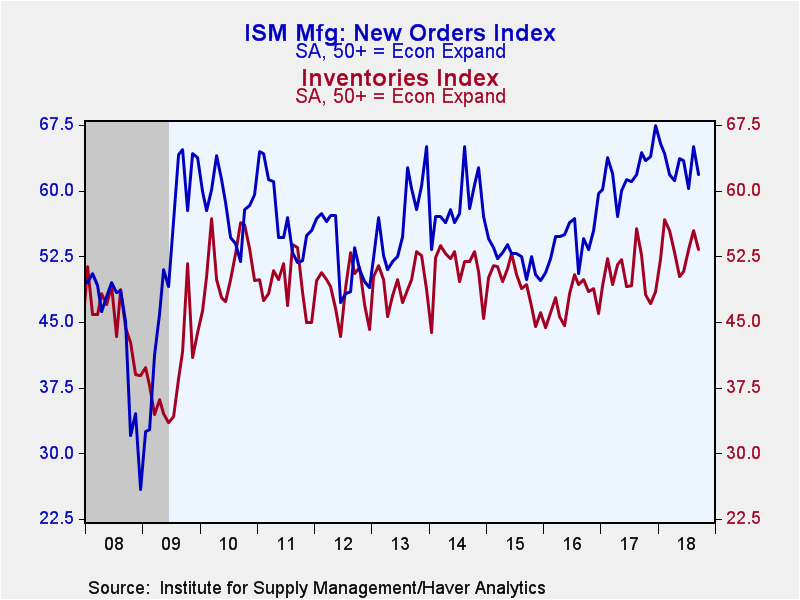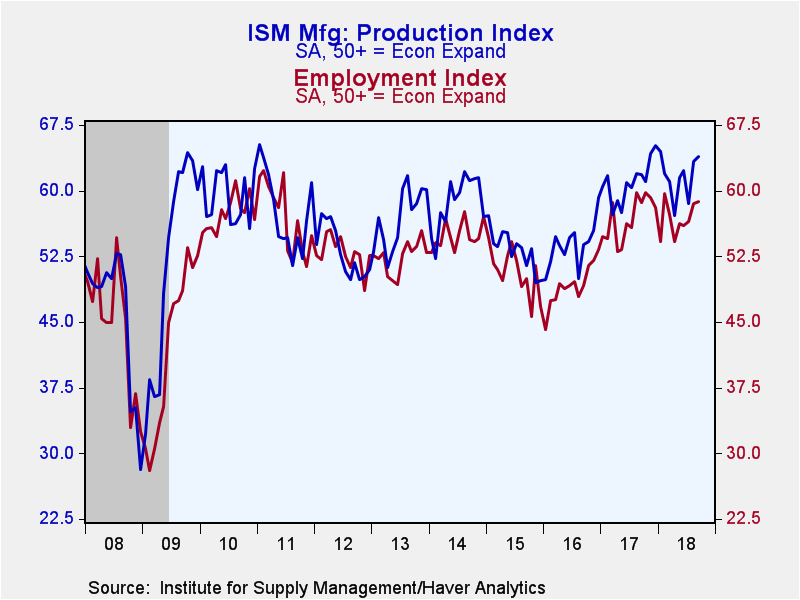 Global| Oct 01 2018
Global| Oct 01 2018ISM Factory Sector Index Eases, Prices Slower Too
Summary
The ISM composite index of activity in the factory sector decreased to 59.8 in September from 61.3 in August. A reading of 60.1 was expected in the Action Economics Forecast Survey. During the last ten years, there has been a 74% [...]
The ISM composite index of activity in the factory sector decreased to 59.8 in September from 61.3 in August. A reading of 60.1 was expected in the Action Economics Forecast Survey. During the last ten years, there has been a 74% correlation between the index level and q/q growth in real GDP.
The September decline in the overall index resulted mainly from a slowdown in the growth of new orders to 61.8 from 65.1 in August. The supplier deliveries index also declined, marking 61.1 following 64.5; this means deliveries were faster because activity was less rigorous. Inventories also eased, dipping back to 53.3 from 55.4.
On the other hand, production did improve a bit, to 63.9 in September from 63.3 in August, and again set a high since January's 64.5. The improvement was indirect, as fewer companies reported lower production, thus adding to the net result. The employment component was also positive, edging up to 58.8 from 58.5; that gain was actually seasonal, as the survey responses before seasonal adjustment showed a small decrease in companies with higher employment and a modest rise in companies with lower employment. During the last ten years, there has been an 85% correlation between the level of the employment index and the m/m change in factory sector payrolls.
The prices paid index, which is not part of the overall index, fell again in September, reaching 66.9 from August's 72.1 (NSA). The September figure is the lowest level since August 2017. It includes a fall in the percentage of companies paying higher prices to 42.3%, the first count below 50% since January and the lowest since last December. The percentage facing falling prices increased to 8.6% from 6.8% in August.
Amongst the other ISM series which are not in the composite, order backlogs eased to 55.7 in September from 57.5 the month before. Export orders showed a small gain to 56.0 from 55.2 and import orders rose to 54.5 from 53.9. This held the import order series to the lower range of the previous couple of months after the second quarter's average of 57.0. Companies' lead-times for ordering production supplies remained relatively long, as they edged down to 68 days from August's 69 days, but these compare to averages of 61 days in 2016 and 2017. So there remains some extra lag in the acquisition of supplies, suggesting that activity is relatively strong.
The ISM figures are diffusion indexes where a reading above 50 indicates expansion. The figures from the Institute for Supply Management can be found in Haver's USECON database; further detail is found in the SURVEYS database. The expectations number is available in Haver's AS1REPNA database.
| ISM Mfg (SA) | Sep | Aug | Jul | Sep'17 | 2017 | 2016 | 2015 |
|---|---|---|---|---|---|---|---|
| Headline Index | 59.8 | 61.3 | 58.1 | 60.2 | 57.4 | 51.4 | 51.3 |
| New Orders | 61.8 | 65.1 | 60.2 | 64.4 | 62.2 | 54.5 | 52.3 |
| Production | 63.9 | 63.3 | 58.5 | 61.9 | 61.0 | 53.8 | 59.3 |
| Employment | 58.8 | 58.5 | 56.5 | 58.7 | 56.8 | 49.2 | 50.7 |
| Supplier Deliveries | 61.1 | 64.5 | 62.1 | 63.4 | 56.8 | 51.8 | 50.8 |
| Inventories | 53.3 | 55.4 | 53.3 | 52.6 | 50.4 | 47.5 | 49.4 |
| Prices Paid Index (NSA) | 66.9 | 72.1 | 73.2 | 71.5 | 65.0 | 53.1 | 40.1 |
Carol Stone, CBE
AuthorMore in Author Profile »Carol Stone, CBE came to Haver Analytics in 2003 following more than 35 years as a financial market economist at major Wall Street financial institutions, most especially Merrill Lynch and Nomura Securities. She has broad experience in analysis and forecasting of flow-of-funds accounts, the federal budget and Federal Reserve operations. At Nomura Securites, among other duties, she developed various indicator forecasting tools and edited a daily global publication produced in London and New York for readers in Tokyo. At Haver Analytics, Carol is a member of the Research Department, aiding database managers with research and documentation efforts, as well as posting commentary on select economic reports. In addition, she conducts Ways-of-the-World, a blog on economic issues for an Episcopal-Church-affiliated website, The Geranium Farm. During her career, Carol served as an officer of the Money Marketeers and the Downtown Economists Club. She has a PhD from NYU's Stern School of Business. She lives in Brooklyn, New York, and has a weekend home on Long Island.









